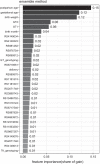Ensemble learning for the early prediction of neonatal jaundice with genetic features
- PMID: 34852805
- PMCID: PMC8638201
- DOI: 10.1186/s12911-021-01701-9
Ensemble learning for the early prediction of neonatal jaundice with genetic features
Abstract
Background: Neonatal jaundice may cause severe neurological damage if poorly evaluated and diagnosed when high bilirubin occurs. The study explored how to effectively integrate high-dimensional genetic features into predicting neonatal jaundice.
Methods: This study recruited 984 neonates from the Suzhou Municipal Central Hospital in China, and applied an ensemble learning approach to enhance the prediction of high-dimensional genetic features and clinical risk factors (CRF) for physiological neonatal jaundice of full-term newborns within 1-week after birth. Further, sigmoid recalibration was applied for validating the reliability of our methods.
Results: The maximum accuracy of prediction reached 79.5% Area Under Curve (AUC) by CRF and could be marginally improved by 3.5% by including genetic variant (GV). Feature importance illustrated that 36 GVs contributed 55.5% in predicting neonatal jaundice in terms of gain from splits. Further analysis revealed that the main contribution of GV was to reduce the false-positive rate, i.e., to increase the specificity in the prediction.
Conclusions: Our study shed light on the theoretical and practical value of GV in the prediction of neonatal jaundice.
Keywords: Genetic variants; Hyperbilirubinemia; Machine learning; Transcutaneous bilirubin.
© 2021. The Author(s).
Conflict of interest statement
The authors declare that they have no competing interests.
Figures






Similar articles
-
Applying data mining techniques to improve diagnosis in neonatal jaundice.BMC Med Inform Decis Mak. 2012 Dec 7;12:143. doi: 10.1186/1472-6947-12-143. BMC Med Inform Decis Mak. 2012. PMID: 23216895 Free PMC article.
-
Primary risk stratification for neonatal jaundice among term neonates using machine learning algorithm.Early Hum Dev. 2022 Feb;165:105538. doi: 10.1016/j.earlhumdev.2022.105538. Epub 2022 Jan 10. Early Hum Dev. 2022. PMID: 35026695
-
[Predictive value of umbilical cord blood bilirubin level for subsequent neonatal jaundice].Zhonghua Er Ke Za Zhi. 2007 Nov;45(11):848-52. Zhonghua Er Ke Za Zhi. 2007. PMID: 18282419 Chinese.
-
Screening methods for neonatal hyperbilirubinemia: benefits, limitations, requirements, and novel developments.Pediatr Res. 2021 Aug;90(2):272-276. doi: 10.1038/s41390-021-01543-1. Epub 2021 May 3. Pediatr Res. 2021. PMID: 33941863 Review.
-
Neonatal hyperbilirubinemia and bilirubin neurotoxicity in hospitalized neonates: analysis of the US Database.Pediatr Res. 2022 Jun;91(7):1662-1668. doi: 10.1038/s41390-021-01692-3. Epub 2021 Aug 24. Pediatr Res. 2022. PMID: 34429513 Review.
Cited by
-
Machine Learning-Based Predictive Modeling of Infrared Spectroscopic Data from Thermal Conversion of Athabasca Bitumen.ACS Omega. 2025 Jul 2;10(27):29836-29855. doi: 10.1021/acsomega.5c04463. eCollection 2025 Jul 15. ACS Omega. 2025. PMID: 40687032 Free PMC article.
-
Automatic deep learning method for analysis and prediction of neonatal hyperbilirubinemia in magnetic resonance imaging.Quant Imaging Med Surg. 2024 Dec 5;14(12):8502-8519. doi: 10.21037/qims-24-1050. Epub 2024 Nov 8. Quant Imaging Med Surg. 2024. PMID: 39698615 Free PMC article.
-
UGT1A1 and BLVRA allele and genotype variants in neonatal patients with hyperbilirubinemia in southern China.Sci Rep. 2024 Oct 28;14(1):25744. doi: 10.1038/s41598-024-77499-z. Sci Rep. 2024. PMID: 39468242 Free PMC article.
-
Improving fraud detection with semi-supervised topic modeling and keyword integration.PeerJ Comput Sci. 2024 Jan 15;10:e1733. doi: 10.7717/peerj-cs.1733. eCollection 2024. PeerJ Comput Sci. 2024. PMID: 38259882 Free PMC article.
-
Stacked machine learning models for accurate estimation of shear and Stoneley wave transit times in DSI log.Sci Rep. 2025 Mar 14;15(1):8821. doi: 10.1038/s41598-025-93730-x. Sci Rep. 2025. PMID: 40087498 Free PMC article.
References
-
- Bhutani VK, Stark AR, Lazzeroni LC, Poland R, Gourley GR, Kazmierczak S, Meloy L, Burgos AE, Hall JY, Stevenson DK, et al. Predischarge screening for severe neonatal hyperbilirubinemia identifies infants who need phototherapy. J Pediatr. 2013;162(3):477–482.e1. doi: 10.1016/j.jpeds.2012.08.022. - DOI - PubMed
Publication types
MeSH terms
Substances
LinkOut - more resources
Full Text Sources

